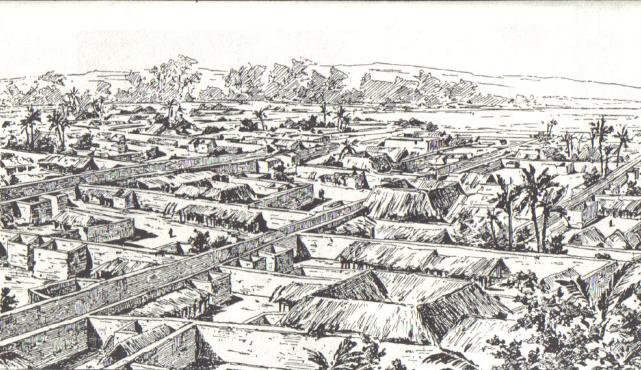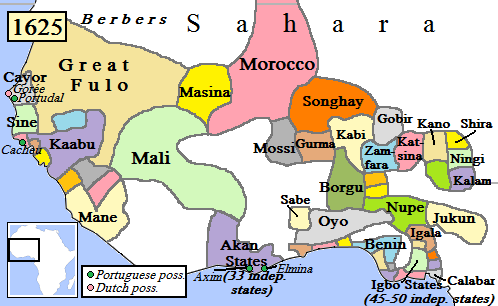|
Ovia (deity)
Ovia is a deity in the traditional religious beliefs of Nigeria, particularly among the Edo people of Benin City. This deity is associated with concepts of peace and providence. Ovia's historical origins can be traced back to the ancient Kingdom of Benin, known for its cultural traditions and governance structure. Emerging during a period of relative stability, Ovia was regarded as a symbol of peace and prosperity within the kingdom. Oral traditions and cultural practices have preserved the significance of Ovia across generations. Ovia was believed to bestow blessings that contributed to the well-being of the kingdom, fostering an environment of harmony and abundance. The deity was invoked during ceremonies, including royal coronations and harvest festivals. Edo's mythology includes stories of Ovia, a woman known for her beauty and unwavering principles. She vowed to marry only a king, setting high standards for her suitors. In a distant land, the king of Oyo learned of Ovia's cap ... [...More Info...] [...Related Items...] OR: [Wikipedia] [Google] [Baidu] |
Nigeria
Nigeria, officially the Federal Republic of Nigeria, is a country in West Africa. It is situated between the Sahel to the north and the Gulf of Guinea in the Atlantic Ocean to the south. It covers an area of . With Demographics of Nigeria, a population of more than 230 million, it is the List of African countries by population, most populous country in Africa, and the List of countries and dependencies by population, world's sixth-most populous country. Nigeria borders Niger in Niger–Nigeria border, the north, Chad in Chad–Nigeria border, the northeast, Cameroon in Cameroon–Nigeria border, the east, and Benin in Benin–Nigeria border, the west. Nigeria is a Federation, federal republic comprising 36 States of Nigeria, states and the Federal Capital Territory, Nigeria, Federal Capital Territory, where its capital, Abuja, is located. The List of Nigerian cities by population, largest city in Nigeria by population is Lagos, one of the largest List of largest cities, metr ... [...More Info...] [...Related Items...] OR: [Wikipedia] [Google] [Baidu] |
Benin City
Benin City serves as the Capital city, capital and largest Metropolitan area, metropolitan centre of Edo State, situated in Nigeria, southern Nigeria. It ranks as the List of Nigerian cities by population, fourth-most populous city in Nigeria, according to the Census in Nigeria, 2006 national census, preceded by Lagos, Kano (city), Kano, and Ibadan. Geography Benin City is located in close proximity to the Benin River, situated approximately to the north, whilst its eastern perimeter lies from Lagos via the arterial road network. The city's municipal boundaries converge with those of several prominent neighbouring towns in Nigeria, southern Nigeria, notably Agbor, Oghara, and Ekpoma. Agriculture Benin City boasts an exceptionally fertile agricultural landscape and serves as the epicentre of Nigeria's thriving Natural rubber, rubber industry. Additionally, the production of palm oil constitutes a substantial sector, further underscoring the city's prominence in Nigeria ... [...More Info...] [...Related Items...] OR: [Wikipedia] [Google] [Baidu] |
Edo State
Edo State, Edo, officially known as Edo State, is a States of Nigeria, state in the South South, South-South Geopolitical zones of Nigeria, geopolitical zone of the Federal Republic of Nigeria. As of 2024, the state was ranked as the List of Nigerian states by population, 20th most populous state (5,250,000) in Nigeria. The estimated state population is around 4,777,000 in 2021. Edo State is the List of Nigerian states by area, 21st largest state by landmass in Nigeria. The state's capital and largest city, Benin City, is the List of Nigerian cities by population, fourth largest city in Nigeria and the centre of the country's rubber industry. Created in 1991 from the former Bendel State, it is also known as the heartbeat of the nation. Edo State borders Kogi State to the north for 133 km and across the Niger River for 81 km to the northeast, Anambra State to the east for about four km across the Niger River, Delta State to the southeast and south for 350 km (218 mi ... [...More Info...] [...Related Items...] OR: [Wikipedia] [Google] [Baidu] |
Edo People
The Edo people, also referred to as the Benin City, Benin people, are an Edoid languages, Edoid-speaking Ethnicity, ethnic group. They are prominently native to seven Edo South Senatorial District, southern Local government areas of Nigeria, local government areas of Edo State, Nigeria. They are speakers of the Edo language and are the descendants of the founders of the Benin Empire, Benin Kingdom, Ogiso Igodo. They are closely related to other Edoid languages, Edoid ethnic groups, such as the Esan people, Esan, the Etsakọ people, Etsakọ, the Isoko language, Isoko and Owan, Urhobo as well as other southern ethnic groups. The names ''Benin City, Benin'' and ''Bini'' are Portuguese people, Portuguese corruptions, ultimately from the word ''Ubini'', which came into use during the reign of Oba of Benin, Oba (ruler) Ewuare, c. 1440. ''Ubini'' is an Edo State, Edo word meaning 'livable', used by Pa Idu, the progenitor of the Edo state people, to describe the area found as a livable ... [...More Info...] [...Related Items...] OR: [Wikipedia] [Google] [Baidu] |
Kingdom Of Benin
The Kingdom of Benin, also known as Great Benin, is a traditional kingdom in southern Nigeria. It has no historical relation to the modern republic of Benin, which was known as Dahomey from the 17th century until 1975. The Kingdom of Benin's capital was Edo, now known as Benin City in Edo State, Nigeria. The Benin Kingdom was one of the oldest and most developed State (polity), states in the coastal hinterland of West Africa. It grew out of the previous Edo people, Edo Kingdom of Igodomigodo around the 11th century AD; it was annexed by the British Empire in 1897, but endured as a non-sovereign monarchy. In the 15th and 16th centuries, the kingdom reached the height of its prosperity, expanding its territory, trading with European powers, and creating a remarkable artistic legacy in cast bronze, iron, brass, carved ivory, and other materials. History Early By the 1st century BC, the Benin territory was partially agricultural; and it became primarily agricultural by around A. ... [...More Info...] [...Related Items...] OR: [Wikipedia] [Google] [Baidu] |
Oyo Empire
The Oyo Empire was a Yoruba people, Yoruba empire in West Africa. It was located in present-day western Nigeria (including the South West (Nigeria), South West zone, Benin Republic, and the western half of the North Central (Nigeria), North Central zone). The empire grew to become the largest Yoruba language, Yoruba-speaking state through the organizational and administrative efforts of the Yoruba people, trade, as well as the military use of cavalry. The Oyo Empire was one of the most politically important states in Western Africa from the late-16th to the early 18th century and held sway not only over most of the other kingdoms in Yorubaland, but also over nearby African states, notably the Fon people, Fon Kingdom of Dahomey in the modern Republic of Benin on its west. History Legend of origin The legendary origins of the Oyo Empire lie with Ọranyan (also known as Ọranmiyan), the last prince of the Yoruba Kingdom of Ile-Ife (Ife). According to oral traditions, Ọranmiyan ... [...More Info...] [...Related Items...] OR: [Wikipedia] [Google] [Baidu] |
Ovia River
The Ovia River or Osse River is a perennial Stream, watercourse in Southwestern Nigeria, flowing through the states of; Kogi State, Kogi, Ondo State, Ondo and Edo State, Edo, before emptying into the Gulf of Guinea. Its watecourse spans approximately through diverse terrain. Geography The Ovia (Osse) River originates in the Apata hills section of the Yorubaland plateau, a region of mildly undulating terrain and rolling hills west of the Niger-Benue confluence and north of the town of Kabba in the region between the present day Ekiti State, Ekiti and Kogi State, Kogi states of Nigeria. This local watershed is also the source of various other rivers in the region, including the Ogun and Osun rivers. The river then begins its southerly flow course, first through Kogi state, after which it forms the local state boundaries between Ondo and northern Edo state before re-entering southern Edo state where it is joined by its major tributary; the Ogbese River before emptying into the lo ... [...More Info...] [...Related Items...] OR: [Wikipedia] [Google] [Baidu] |
Ayelala
Ayelala is a female deity of justice and retribution widely feared for her instant punishments for those who commit criminal offences. She is also known as a goddess of truth, oath and divination. She originated from the areas inhabited by the Ilaje, Ikale and apoi ethnic groups in southwestern Nigeria, but later spread to other parts of the country, especially Benin and Edo State. She is often invoked by people who seek justice or revenge against their enemies, or by those who want to prove their innocence or expose the truth. Ayelala is believed to possess great powers which she uses against varying forms of social vice, such as armed robbery, sexual offences, and witchcraft to mention a few. Origin and spread One legend regarding Ayelala's origin suggests that she was a slave woman initially sacrificed by the Ilaje people in an attempt to reconcile with the Ijaw people. This gesture followed an adulterous affair between an Ilaje man and an Ijaw woman that had triggered a feu ... [...More Info...] [...Related Items...] OR: [Wikipedia] [Google] [Baidu] |



